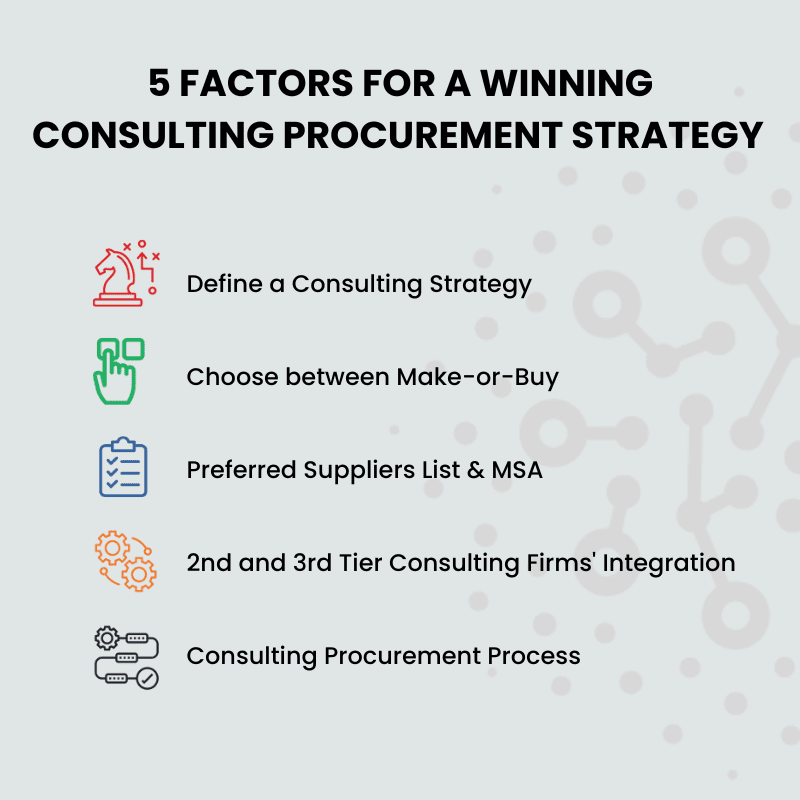To develop a successful consulting procurement strategy, it’s important to have a deep understanding of the overall strategy of your organization, the Consulting Market, and past performance within the category.
This strategy should align with your company’s Procurement Guidelines, while being customized specifically for Consulting.
A good consulting procurement strategy should take into account matters such as supplier relationships and risk management. All these considerations ensure that time and effort is well spent in picking the right vendors while also managing any risks associated with them.
Developing a strong consulting procurement strategy can have long term benefits for an organization’s bottom-line but crafting a procurement strategy for the consulting category can be quite a challenge.
It requires an understanding of both the wider procurement strategy, along with the specifics of the consulting market. What may work for one company likely won’t work for another, so it’s important to tailor any strategy to the specific consulting need.
Although guidelines should always inform and shape your strategies, flexibility is important when dealing with such niche markets.
A successful consulting procurement strategy must take into account past performance as well as future objectives, allowing the organization to make informed decisions based on what’s worked before and where they want to be headed in the long run.
At times this will require some out-of-the-box thinking that respects existing protocols while still pushing boundaries in pursuit of better value.
To help you navigate this process, we’ve identified five essential factors to explore that can contribute to effective outcomes, as well as common pitfalls to avoid.
By following these guidelines, you can develop a Consulting procurement strategy that sets you up for success in the Consulting Category.
Consulting Procurement Strategy – 5 Essential Factors to Explore
1. Define a Consulting Strategy
A well-crafted consulting procurement strategy can be the secret weapon to bridge the gap between strategic planning and demand management. If strategized correctly, it can be extremely beneficial in helping organizations reach their objectives faster.
It allows teams to identify projects or project areas where using consultants will create the most positive outcome and impact in the shortest amount of time. With thoughtful planning that is tailored to your organization’s needs over a period of up to two years, you can maximize efficiency by knowing exactly which key actions support your strategy and where lesser effort should be allocated.
It helps ensure that precious energy and resources are not wasted pursuing initiatives without adequate reward – ultimately leaving you steps closer to achieving success!
Pitfall – Failing to provide a proper time frame, delegating extra effort or human resources to projects that are smaller, or not enough resources, can backfire.
2. Choose Between Make-or-Buy Strategy
Another crucial step in developing a consulting procurement strategy for the consulting category is defining a make-or-buy strategy. Demand Management and the Make-or-Buy Strategy should both be (re)evaluated because they are intertwined.
The objective is to create a decision-making process that is better and more efficient, which frequently includes a decision framework and a decision matrix. This framework enables choosing which initiatives should be given top priority and the ideal method for carrying them out.
As an example, think of a major transformation exercise for an insurance company across all sites in Asia to implement new development methodologies inspired by the lean startup and the scrum principles.
A hybrid team made up of outside consultants and your own in-house scrum masters may be used to complete the project, or the consulting business could provide all necessary resources.
Pitfall – Missing out on fees’ reduction due to the inadequate decision process, weak buy-in from the teams, and uneven knowledge transfer from external firms.
3. Preferred Supplier List & Master Service Agreements
Building a preferred supplier list may sound intimidating, but it certainly packs a punch when it comes to efficiency. Basically, this strategy takes advantage of the fact that typically, 80% of your needs will be met by only 20% of your Suppliers – so why not try and make use of that information?
By utilizing both past expenses and future strategies, you can figure out what suppliers you’re likely to be dealing with. Additionally, it allows for more negotiating power and provides an opportunity for frame contracts or Master Service Agreements that include pre-arranged terms and conditions as well as sweet volume discounts.
All in all, the preferred supplier list approach definitely has its perks!
Pitfall – Not having clear expectations, or deficiency in the list of Preferred Suppliers can affect the projects’ success in various ways.
4. 2nd and 3rd Tier Consulting Firms Integration
When it comes to cutting costs and increasing return on investment, many businesses are beginning to explore the option of leveraging 2nd and 3rd tier consulting firms. Working with smaller companies allows business lines to target niche needs, while maintaining control of tail spend.
Additionally, as these small to mid-sized consultation firms may charge lesser than larger companies for their services, businesses can save a lot of money by working with them – reducing average costs and in turn improving ROI significantly.
As such, 2nd and 3rd tier consulting firms are increasingly gaining popularity among businesses that are keen to keep an eye on their budget while meeting their desired objectives efficiently.
Pitfall – Do not miss out on identifying specialized niche providers who can deliver excellent performance at lower rates, that other general providers won’t.
5. Consulting Procurement Process
When it comes to buying consulting services, RFPs are an amazing tool that can really set the process off on the right track. Even if you create a simplified version, it’s important to write one because it sets expectations so everyone knows what is expected in terms of scope and deliverables.
Not only that, but crafting an efficient RFP can maximize the success of your project as well as the performance of procurement. It also helps to segment projects based on size, importance, potential impact and complexity to determine which type of process should be used – such as whether or not there should be an RFI or competition, or if you need procurement support.
Pitfall – Make sure you leave room in your RFP to the Consulting Firm to bring innovative ideas and approaches. Lack of clarity in your expectations and the criteria of evaluation in the RFP, might not produce the best proposals.
One Final Tip…
Once you’ve made your decision, it’s essential that you ensure everything is formalized. The key is to use a Statement of Work (SoW) to detail the agreed expectations – even if there are only a few!
This SoW should explain all deliverables (and when they will be delivered!), the timeline for each step of the project, and any other applicable terms and conditions needed for both parties to move forward in harmony.
It’s a crucial step but doesn’t have to take too much time – just remember the added value of planning ahead and locking down your contractual setup from the get-go.
consulting procurement strategy consulting procurement strategy consulting procurement strategy consulting procurement strategy consulting procurement strategy consulting procurement strategy
consulting procurement strategy consulting procurement strategy consulting procurement strategy consulting procurement strategy consulting procurement strategy consulting procurement strategy

How Consource Can Help?
Consource can help you to expedite consultant sourcing by 50% using our smart user interface, self-service portal, and templates libraries. With concource you can source the best value-for-money consultants through competition by combining your panel and our network.









0 Comments